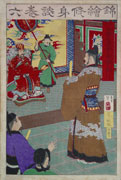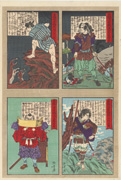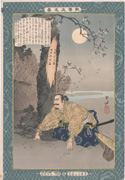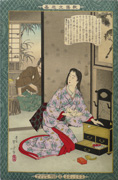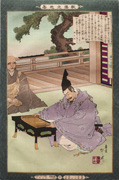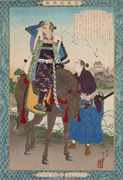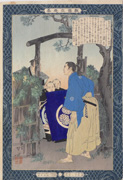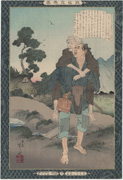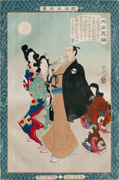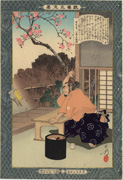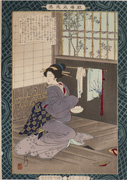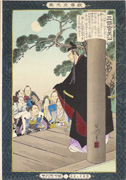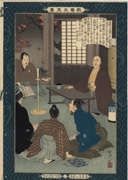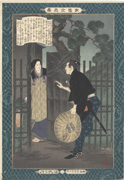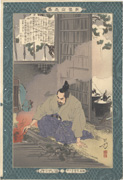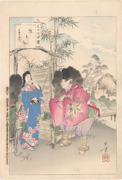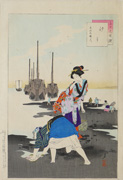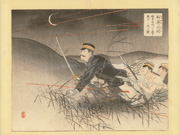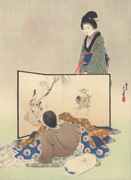Prints in Collection
Yamanouchi Kazutoyo no tsuma from the series Instructive Models of Lofty Ambition,
August 1888
IHL Cat. #599
Nawa Nagatoshi
from the series Instructive Models of Lofty Ambition, August 1888
IHL Cat. #2084
Takasugi Shinsaku
from the series Instructive Models of Lofty Ambition, November 1890
IHL Cat. #1399
Sano Tsuneyo
from the series Instructive Models of Lofty Ambition, November 1890
IHl Cat. #1400
-intentionally left blank-
-intentionally left blank-
Naval Officers Discussing the Battle Strategy for the Invasion of China, 1894
IHL Cat. #444
Bijin showing a folding screen to a reclining man, c. 1896
IHL Cat. #1713
-intentionally left blank-
-intentionally left blank-
Biographical Data
Biography
Mizuno Toshikata 水野年方 (1866-1908)Gō (artist names): Ōsai 応斉 and Shōsetsu 蔗雪 (these gō are often used in the artist's seals)
Sources: : Artelino website http://www.artelino.com/forum/artists.asp?act=&art=132&alp=g&cay=1&cp=1&sea=&tie=Ginko%20Adachi%20active%201874-1897; Guide to Modern Japanese Woodblock Prints: 1900-1975, Helen Merritt, University of Hawaii Press, 1992; The Sino-Japanese War, Nathan Chaikin, self-published, 1983, pg. 36; Imperial Japan: The Art of the Meiji Era (1868-1912), Frederick Baekeland, Herbert F Johnson Museum of Art, Cornell University, 1980, p. 136; The World of the Meiji Print: Impressions of a New Civilization, Julia Meech-Pekarik, Weatherhill, 1986, p. 220-221; The Hotei Encyclopedia of Japanese Woodblock Prints, Amy Reigle Newland, Hotei Publishing Company, 2005, p. 251, 253; International Fine Print Dealers Association website http://www.printdealers.com/content/node/2225; Woodblock Kuchi-e Prints: Reflections of Meiji Culture, Helen Merritt and Nanako Yamada, University of Hawaii Press, 2000, p. 209-210 and as footnoted.
Toshikata was born Mizuno Kumajirō in 1866 in the Yamamoto-chō in the Kanda district of Tokyo to a plasterer's family. When he was about thirteen years old his father, Nonaka Kichigoro, sent him to study with Yoshitoshi Tsukioka (1839-1892), but his father removed him from Yoshitoshi's studio and sent him to a relative of his mother to earn his living as a painter of ceramics.1 In 1882, however, he returned to Yoshitoshi's studio. Yoshitoshi would give him the character toshi (年 or its variant 秊) from his own name as the first character of his art name Toshikata and eventually designate him as his successor. Yoshitoshi is also said to have passed his artist seals along to Toshikata2. He also apprenticed for a time with the ceramic painter Yamada Ryūtō and studied traditional Japanese painting (nanga) with Shibata Hōshū and Watanabe Shōtei (aka Watanabe Seitei, 1851-1918).
Toshikata was born Mizuno Kumajirō in 1866 in the Yamamoto-chō in the Kanda district of Tokyo to a plasterer's family. When he was about thirteen years old his father, Nonaka Kichigoro, sent him to study with Yoshitoshi Tsukioka (1839-1892), but his father removed him from Yoshitoshi's studio and sent him to a relative of his mother to earn his living as a painter of ceramics.1 In 1882, however, he returned to Yoshitoshi's studio. Yoshitoshi would give him the character toshi (年 or its variant 秊) from his own name as the first character of his art name Toshikata and eventually designate him as his successor. Yoshitoshi is also said to have passed his artist seals along to Toshikata2. He also apprenticed for a time with the ceramic painter Yamada Ryūtō and studied traditional Japanese painting (nanga) with Shibata Hōshū and Watanabe Shōtei (aka Watanabe Seitei, 1851-1918).
In 1887, on Yoshitoshi's recommendation, he succeeded Yoshitoshi as the illustrator at the newspaper Yamato shinbun, where he achieved acclaim. He worked at the Yamato shinbum until 1894. During the Sino-Japanese War (1894-1895), which brought about a brief resurgence of woodblock printmaking, he created a large body of work depicting battle scenes. His work is some of the best to be produced during that period.
He was active as a painter of genre and historical subjects, receiving awards of merit in 1898, 1899, 1900 and 1902 at the joint Japan Art Institute/Japan Painting Association (Nihon Bijutsuin/Nihon Kaiga Kyōkai) exhibition and was active in the Japan Art Society (Nihon Bijutsu Kyōkai), and the Japan Painting Society (Nihon Kaiga Kyōkai) and the Academy of Japanese Art (Nippon Bijutsuin).
As times became difficult for Japanese printmakers, with ukiyo-e printmaking falling out of style due to the introduction of photography and lithography, Toshikata turned toward the design of illustrations for novels (kuchi-e), literary journals, such as Bungei kurabu, Miyako no hana (Flower of the capital) and Shin shosetsu (New novel), and the design of fashion plates for department stores, such as the series Mitsukoshi: Brocades of the Capital (Mitsukoshi miyako no nishiki, 1905-6), which advertised Meiji fashions for the Mitsui Department Store.
Toshikata published a number of series of bijin prints and genre scenes, featuring women and children, including print sets such as Thirty-six Types of Beauty (Sanjūrokkasen), 1891, published by Kokkeidō and Ancient Beauties (Kodai bijin). Satō Shōtarō 佐藤章太郎 and Akiyama Buemon 秋山武右衛門 were two of his main publishers. After the turn of the century, Toshikata remained a well-known painter, printmaker and illustrator and is credited with raising the status of painters from the ukiyo-e lineage.
Toshikata's role as a teacher is significant. His students Kaburaki Kiyokata (1878-1972), Ikeda Terukata 池田輝方 (1883-1921) and Ikeda Shoen 池田蕉園 (1888-1917) are known today as successful Nihonga bijinga painters and print designers. He also had a number of women students, including his wife, Mizuno Hidekata (nee Ichikawa), and Ikeda Shoen.
He was demanding of his students and did not encourage freedom of expression. Although he cared deeply about the status of ukiyo-e, his heart was in historical painting. As a young man he lived in Kanda and studied tokiwazu, the shamisen music that accompanied joruri (a type of sung narrative with shamisen accompaniment, typically found in bunraku, a traditional Japanese puppet theater) performance. In 1895, having achieved some success as a painter he moved to Yanaka Shimizu-cho. In his new home he practiced archery, yokyoku (noh chanting), and the game of go, all avocations related to historical painting. He died in April 1908 at age forty-two, reportedly from overwork.
1 The New Wave: Twentieth-century Japanese prints from the Robert O. Muller Collection, Amy Reigle Stephens, Bamboo Publishing Ltd, London & Hotei-Japanese Prints, Leiden, 1993, p. 92.
2 Yoshitoshi's One Hundred Aspects of the Moon, John Stevenson, Hotei Publishing, 2001. p. 36.
Artist Signatures (a sampling)
Notes: 応需 ōju [by request]
 ōju Toshikata ga unread seal |  應需年方絵 ōju Toshikata-e 年方 sealed Toshikata, 1895 |  應需年方絵 ōju Toshikata-ewith Toshikata-e seal, 1895 |  ōju Toshikata-e with Ōsai seal, 1895 |  応需年方 ōju Toshikata 応斎年方 Ōsai Toshikata seal |  ōju Toshikata-e |
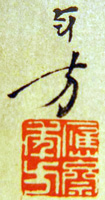 Toshikata with Shosetsu-Toshikata seal |  Toshikata 応需 sealed Ōsai |  Toshikata 応需 sealed Ōsai | 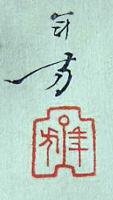 年方 Toshikata 年方 Toshikata seal |  年方 Toshikata 年方 Toshikata seal |  年方 Toshikata 年方 Toshikata seal |
 応需年方 ōju Toshikata年方 sealed Toshikata |  應需年方絵 ōju Toshikata-e蕉雪 sealed Shō and Setsu |  Toshikata seal |  Toshikata |  年方 Toshikata 応斎 年方 sealed Ōsai and Toshikata |  年方 Toshikata 年方蕉雪 sealed Toshikata and Shōsetsu |
